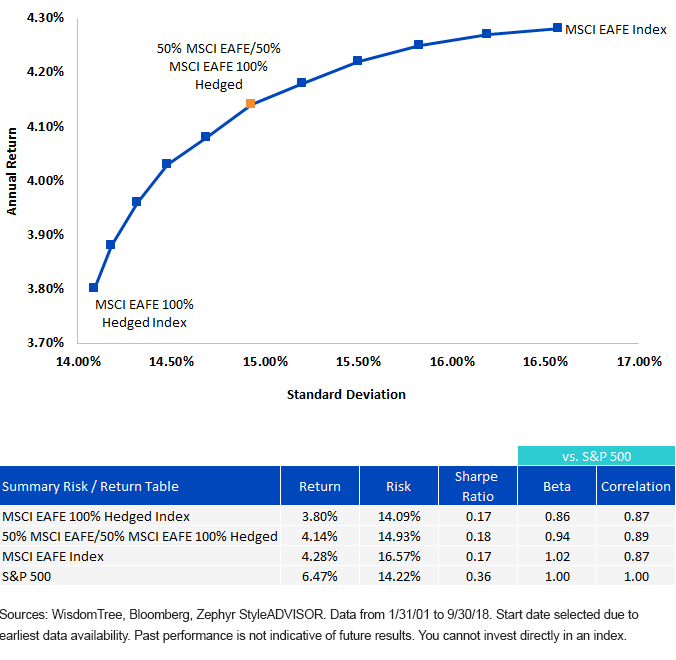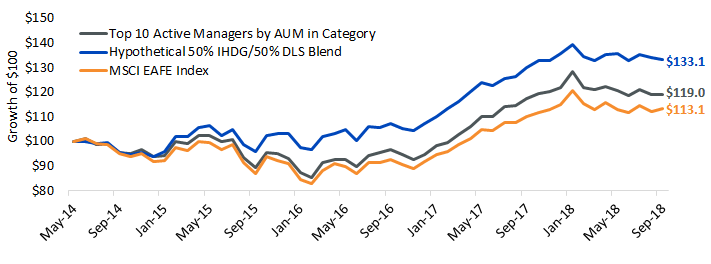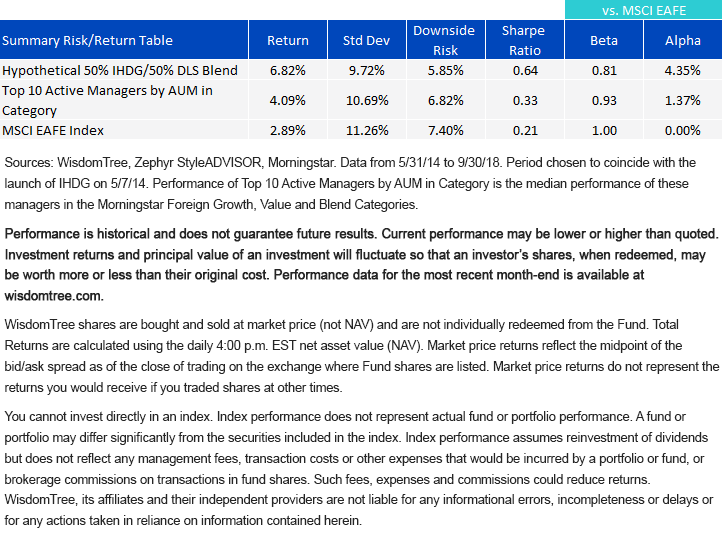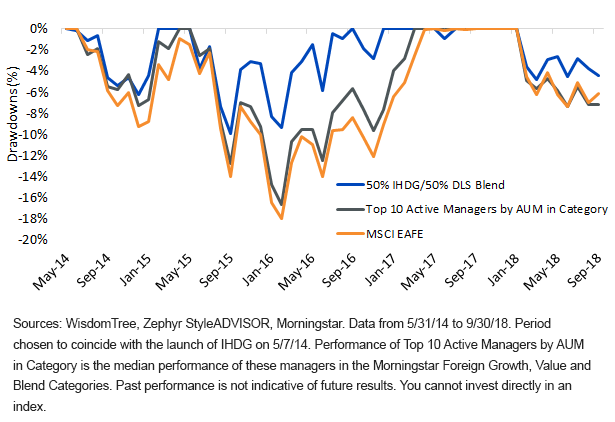Enhancing International Portfolios via FX Risk & Factors


In a recent post, we highlighted our rationale for why we believe investors should consider maintaining exposure to developed international equities in the current market environment. In this post, we dive deeper into how our approach stacks up against some of the biggest active managers in the category. As we will show, currency hedging and small caps are two important themes that can potentially help investors generate excess returns and limit downside risk across developed international markets.
The 50% Currency-Hedged Baseline
In reviewing the returns in the below table of the MSCI EAFE 100% Hedged Index compared to the MSCI EAFE Index going back to 2001, the unhedged Index had a return advantage of just under 50 basis points (bps) annualized—a modest but notable performance advantage. With returns between the two Indexes so close over the long run, why should investors even care about currency hedging? A few points to consider:
- Incremental Volatility: While we don’t know if the currency exposure will be a headwind or tailwind going forward, our research has shown that taking on currency risk across broad international equity allocations has consistently increased risk (volatility). Over the time frame back to 2001, the additional return from bearing currency risk resulted in 248 bps of additional volatility—16.57% versus 14.09%.
- Diversification: Given that currency risk tends to increase volatility, the only legitimate justification to assume this risk is that you are expressing a market view or if the currency exposure were a diversifier to your existing portfolio. When comparing returns to the S&P 500, a proxy for the core of most dollar-based investors’ portfolios, we see the hedged and unhedged Indexes produced the same correlation of 0.87. Simply put, currency exposure didn’t enhance diversification.
- Cost to Hedge: In today’s environment of rising interest rates in the U.S. and negative short-term rates in markets such as the eurozone and Japan, hedging costs for dollar-based investors is negative against most major currencies. From the perspective of U.S.-based investors, hedging developed market currency risk results in positive carry. In other words, investors are getting paid to hedge.
- Tracking Error: At the end of the day, the reality of the allocation decision for many investors is typically that they want to have some exposure to currencies so that they will not dramatically lag an unhedged benchmark if there is a period of dollar weakness. This means investors could experience slightly more absolute volatility in their portfolios in the pursuit of lower tracking error versus an unhedged benchmark. For this reason, we often encourage investors to think about a 50% hedged approach as their baseline. In this framework, investors should be agnostic to currency hedging since 50% may outperform and 50% may underperform. As the efficient frontier shows below, one can see a 50/50 blend offered the best risk/return trade-off (i.e., the highest Sharpe ratio).
MSCI EAFE Efficient Frontier

For definitions of terms in the charts, please visit our glossary.
A Multifactor Portfolio with Potential Downside Risk Protection
Taking this 50% currency-hedged approach one step further, we can look at how the fully hedged WisdomTree International Hedged Quality Dividend Growth Fund (IHDG), launched in May 2014, pairs with the unhedged WisdomTree International SmallCap Dividend Fund (DLS), one of WisdomTree’s original Funds launched in June 2006. While our research has shown that currency fluctuations should generally be viewed as uncompensated risk to be hedged, we advocate that the small-cap premium can reward investors over the long run and has not contributed as much incremental risk in the developed international market as might be expected.
The Index that IHDG tracks selects 300 large-cap dividend-paying companies from the developed international universe based on profitability and growth characteristics in an attempt to identify companies with attractive future dividend growth. This Index, just like the Index for DLS, is reconstituted on an annual basis, and constituents are weighted based on their contribution to the total index Dividend Stream®. We believe this fundamental rebalance is critical to imposing a value tilt to both Indexes.
A hypothetical portfolio of 50% IHDG and 50% DLS can provide investors with exposure to three important factors—quality, value and size—while also providing the potential for greater protection to currency moves than typically offered by most active managers. Unsurprisingly, this hypothetical blended approach outperformed the median performance of the top 10 largest active managers in the Morningstar Foreign Growth, Value and Blend Categories over a period in which the dollar has generally strengthened. In our view, it seems that most active managers have unhedged portfolios that rely heavily on dollar weakness to generate performance. The hypothetical blend of IHDG and DLS outperformed the active managers by more than 250 bps, and nearly doubled the performance on a risk-adjusted basis.
While a common defense of active management is that it provides greater downside protection and mitigates risks in portfolios, the last four+ years have shown mixed evidence to support that case. While the median performance of the top 10 active managers has a slightly lower standard deviation and downside risk than the MSCI EAFE Index, their approach has resulted in significantly higher risk than our blending of passive funds.
Cumulative Growth of $100
May 31, 2014–September 30, 2018


For definitions of terms in the charts, please visit our glossary.
For standardized performance of the Funds in the chart, please click their respective tickers: IHDG, DLS.
Turning our attention to drawdowns, this time frame has avoided dipping into a bear market, but there have been several sharp corrections. The corrections of late 2015, early 2016 and early 2018 all show that the performance of the active managers provided minimal, if any, downside protection compared to the MSCI EAFE Index, and significantly less than the hypothetical IHDG/DLS blend.
Monthly Rolling Drawdowns
May 31, 2014–September 30, 2018

For investors who want to take advantage of the valuation opportunity in international equities, we would advise considering at least a 50% currency-hedged approach to mitigate the risks of international investing, while also tapping into factors proven to enhance equity returns, such as size, value and quality. From the WisdomTree family of international equity offerings, we favor a blending of IHDG and DLS to fit these criteria.
Important Risks Related to this Article
There are risks associated with investing, including possible loss of principal. Foreign investing involves special risks, such as risk of loss from currency fluctuation or political or economic uncertainty. To the extent the Fund invests a significant portion of its assets in the securities of companies of a single country or region, it is likely to be impacted by the events or conditions affecting that country or region. Dividends are not guaranteed, and a company currently paying dividends may cease paying dividends at any time. Investments in currency involve additional special risks, such as credit risk and interest rate fluctuations. Derivative investments can be volatile, and these investments may be less liquid than other securities, and more sensitive to the effects of varied economic conditions. As this Fund can have a high concentration in some issuers, the Fund can be adversely impacted by changes affecting those issuers. The Fund invests in the securities included in, or representative of, its Index regardless of their investment merit, and the Fund does not attempt to outperform its Index or take defensive positions in declining markets. Due to the investment strategy of this Fund, it may make higher capital gain distributions than other ETFs. Please read each Fund’s prospectus for specific details regarding the Fund’s risk profile.


